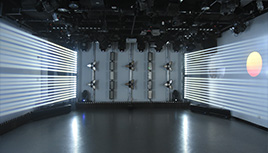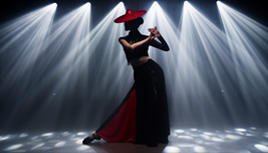Safety Guidelines for Installing Stage Lights
2025-02-04 Post By: Longmangroup
When it comes to stage lighting, safety is a top priority. The installation and operation of stage lights require careful planning and adherence to safety standards to ensure both the equipment and crew are protected. Whether you’re setting up LED stage lights for a live performance, theater production, or concert, following proper safety protocols is essential for a smooth and secure installation process.
1. Understand Your EquipmentBefore beginning installation, ensure that you are familiar with the specific stage light models you are using. Each lighting fixture, such as moving heads, PAR lights, and LED stage lights, has unique installation requirements. Refer to the manufacturer's manual for details on weight, power requirements, and recommended mounting techniques.
2. Proper Mounting and Rigging
Stage lighting typically requires mounting high above the stage, often on trusses or overhead grids. For safety reasons, it’s important to:
- Use secure mounting hardware rated for the weight of the lights.
- Ensure all rigging points are properly aligned and locked to prevent accidental falls.
- Never overload the truss or rigging system with more weight than it’s rated to handle.
- Perform regular inspections of the mounting systems to check for wear and tear.
Electrical safety is crucial when installing stage lighting. Follow these guidelines to avoid electrical hazards:
- Always turn off power before beginning the installation of any lights or related equipment.
- Ensure all wiring is correctly grounded and insulated to prevent short circuits or electric shocks.
- Use circuit breakers and surge protectors to protect both the lights and the crew from electrical issues.
- Double-check that the voltage and wattage of the LED stage light match the power supply specifications.
Stage lights, particularly traditional incandescent bulbs and certain LED stage lights, generate heat. Proper ventilation is necessary to prevent overheating:
- Ensure there is enough airflow around lights to dissipate heat.
- For LED stage lights, check the manufacturer’s recommendation regarding ambient temperature limits to avoid damage.
- Make sure that cables are not obstructing airflow, and always use heat-resistant materials.
Cabling and wiring are an essential part of the stage lighting setup, but they also pose safety risks. To minimize hazards:
- Secure cables along the floor or walls to prevent tripping or accidental unplugging.
- Use cable covers or clips to ensure cables are protected from damage and clearly marked.
- Always test all cables and connections before final installation to ensure they are working properly.
Any team members involved in the installation process should be properly trained in stage lighting safety. Ensure that everyone understands the correct installation techniques and emergency procedures. In addition, personal protective equipment (PPE) such as hard hats, gloves, and non-slip shoes should be worn to protect against potential accidents.
7. Periodic Maintenance and Inspections
Once the lights are installed, safety doesn't end there. Regular maintenance and inspections are necessary to keep the system running safely. Schedule routine checks to inspect wiring, mounting hardware, and the condition of the lights themselves. It’s also important to monitor the functioning of LED stage lights, as older LEDs can degrade, reducing performance and potentially causing hazards.
And there are other tips for you to consider:
Planning the Lighting Layout
Before any installation begins, it’s essential to plan the layout of your stage lighting carefully. Understand the size of the venue, the types of performances being staged, and the desired atmosphere. The installation layout should ensure that lights are placed at the optimal height and angle for both visual impact and safety.- Example: For a concert, moving head lights may need to be positioned overhead on a truss system, while LED stage lights could be used for a broader wash effect. Ensure that there is adequate clearance above performers, as well as the proper mounting gear to secure the lights.
- Check mounting hardware for signs of wear or looseness.
- Ensure all wiring is intact and free from fraying or other damage.
- Clean the lenses and housings of LED stage lights to ensure maximum brightness and efficiency.
1. Moving Head Light
- Installation Considerations:
- Mounting: Moving head lights are typically mounted on overhead trusses or grids, requiring sturdy support to handle the movement and weight of the fixture.
- Power Requirements: Ensure that the power supply meets the voltage and wattage needs of the moving head.
- Attention to Detail: Because of their motorized movement, check for proper alignment to prevent unnecessary wear on the internal mechanisms.
- Safety Tip: Double-check the rigging system to ensure it can handle the dynamic movements of the light.
2. PAR Light
- Installation Considerations:
- Mounting: PAR lights are often used for general wash effects and are typically mounted on a fixed or adjustable bracket for easy angle adjustments.
- Power Requirements: Verify that the PAR light has the correct power supply, especially when using higher-wattage incandescent models.
- Attention to Detail: Ensure the light is properly shielded to prevent direct exposure of the hot lamp to other materials, minimizing the risk of overheating.
3. Wash Light
- Installation Considerations:
- Mounting: Wash lights need to be carefully positioned to cover the stage with an even spread of light. Adjustable mounts help achieve the desired coverage.
- Power Requirements: Wash lights typically have higher wattages, so a reliable power source and surge protection are important.
- Attention to Detail: Ensure that the mounting is secure, as a misplaced or loose fixture can create uneven coverage across the stage.
4. Pixel Background Light
- Installation Considerations:
- Mounting: These lights are used for background effects and require precise positioning to create the right pixelated effects.
- Power Requirements: Pixel lights, often LED-based, consume less power but still require an adequate power supply.
- Attention to Detail: Cabling for these lights can be tricky, as they are often part of a larger array, so ensuring secure and organized wiring is key.
5. Laser Light
- Installation Considerations:
- Mounting: Lasers should be mounted in secure, fixed positions, as their beams need to remain steady for effect precision.
- Power Requirements: Laser lights require careful power management to avoid overloads, especially when using high-power lasers.
- Attention to Detail: Use protective casings to avoid accidental exposure to the laser beam, which could be dangerous.
6. Gobo Light
- Installation Considerations:
- Mounting: Gobo lights are often mounted in fixed positions to project patterns onto the stage. Rigging must be secure to avoid shifts in alignment.
- Power Requirements: Ensure that the power supply is sufficient to handle both the light’s power consumption and any additional features like rotating gobos.
- Attention to Detail: Verify that gobo projectors are focused correctly, ensuring that patterns appear clearly on stage surfaces.
7. Beam + Wash + Spot Hybrid Light
- Installation Considerations:
- Mounting: Hybrid lights are versatile and require careful mounting for easy adjustment between beam, wash, and spot modes.
- Power Requirements: Hybrid lights often have high power demands, especially in beam mode, requiring a stable and powerful electrical system.
- Attention to Detail: Pay close attention to the wiring as hybrid fixtures tend to be more complex in their power needs and lighting controls.
8. Profile and Ellipsoidal Light
- Installation Considerations:
- Mounting: These lights are often used for spot effects and need to be precisely aligned for accurate focusing.
- Power Requirements: Verify power connections and ensure compatibility with the stage’s electrical infrastructure.
- Attention to Detail: Regularly check for any wear on the lenses or focus mechanisms to ensure optimal lighting performance.
9. Strobe Lights
- Installation Considerations:
- Mounting: Strobe lights are often mounted to produce intense flashes over specific areas, typically high above the stage.
- Power Requirements: Strobe lights can require substantial electrical capacity, particularly if using high-output models.
- Attention to Detail: Ensure safety measures are in place to prevent accidental exposure to the intense light flashes that can cause visual discomfort.














